FEM Modelling of the Influence of the Remaining Windings on the Frequency Response of the Power Transformer
Abstract
1. Introduction
2. Frequency Response (FR) Interpretation
3. Winding models
3.1. Physical Model
3.2. Computer Models
3.3. Electromagnetic Field Calculations
4. Core Modelling
4.1. Equivalent Magnetic Permeability of the Core
4.2. Equivalent Conductivity
5. Results
5.1. Equivalent Parameters of Core Material
5.2. Equivalence of 2D and 3D Models
6. Conclusions
Author Contributions
Funding
Conflicts of Interest
References
- Tenbohlen, S.; Jagers, J.; Bastos, G.; Desai, B.; Diggin, B.; Fuhr, J.; Gebauer, J.; Kruger, M.; Lapworth, J.; Manski, P. Transformer Reliability Survey; Technical Brochure 642 CIGRE: Paris, France, 2015. [Google Scholar]
- Tenbohlen, S.; Coenen, S.; Djamali, M.; Müller, A.; Samimi, M.H.; Siegel, M. Diagnostic Measurements for Power Transformers. Energies 2016, 9, 347. [Google Scholar] [CrossRef]
- Senobari, R.K.; Sadeh, J.; Borsi, H. Frequency response analysis (FRA) of transformers as a tool for fault detection and location: A review. Electr. Power Syst. Res. 2018, 155, 172–183. [Google Scholar] [CrossRef]
- IEC 60076-18: 2012. Power Transformers—Part 18: Measurement of Frequency Response; IEC Standard: Geneve, Switzerland, 2012. [Google Scholar]
- IEEE Guide for the Application and Interpretation of Frequency Response Analysis for Oil-Immersed Transformers. In IEEE Std C57.149-2012; Institute of Electrical and Electronics Engineers (IEEE): Piscataway, NJ, USA, 2013.
- Predl, F. Interpretation of Sweep Frequency Response Analysis (SFRA) Measurement Results; OMICRON: Sydney, Australia, 2016. [Google Scholar]
- Bagheri, M.; Phung, B.; Blackburn, T. Influence of temperature and moisture content on frequency response analysis of transformer winding. IEEE Trans. Dielectr. Electr. Insul. 2014, 21, 1393–1404. [Google Scholar] [CrossRef]
- Abu-Siada, A.; Hashemnia, N.; Islam, S.; Masoum, M.A. Understanding power transformer frequency response analysis signatures. IEEE Electr. Insul. Mag. 2013, 29, 48–56. [Google Scholar] [CrossRef]
- Miyazaki, S.; Mizutani, Y.; Tahir, M.; Tenbohlen, S. Influence of employing different measuring systems on measurement repeatability in frequency response analyses of power transformers. IEEE Electr. Insul. Mag. 2019, 35, 27–33. [Google Scholar] [CrossRef]
- Banaszak, S.; Gawrylczyk, K.; Trela, K.; Bohatyrewicz, P. The Influence of Capacitance and Inductance Changes on Frequency Response of Transformer Windings. Appl. Sci. 2019, 9, 1024. [Google Scholar] [CrossRef]
- Banaszak, S.; Szoka, W. Transformer Frequency Response Analysis with the Grouped Indices Method in End-to-End and Capacitive Inter-Winding Measurement Configurations. IEEE Trans. Power Deliv. 2020, 35, 571–579. [Google Scholar] [CrossRef]
- Samimi, M.H.; Tenbohlen, S. FRA interpretation using numerical indices: State-of-the-art. Int. J. Electr. Power Energy Syst. 2017, 89, 115–125. [Google Scholar] [CrossRef]
- Liu, J.; Zhao, Z.; Tang, C.; Yao, C.; Li, C.; Islam, S. Classifying Transformer Winding Deformation Fault Types and Degrees Using FRA Based on Support Vector Machine. IEEE Access 2019, 7, 112494–112504. [Google Scholar] [CrossRef]
- Zhao, Z.; Tang, C.; Zhou, Q.; Xu, L.; Gui, Y.; Yao, C. Identification of Power Transformer Winding Mechanical Fault Types Based on Online IFRA by Support Vector Machine. Energies 2017, 10, 2022. [Google Scholar] [CrossRef]
- Picher, P.; Lapworth, J.; Noonan, T.; Christian, J. Mechanical Condition Assessment of Transformer Windings Using Frequency Response Analysis; Technical Brochure 342 CIGRE: Paris, France, 2008. [Google Scholar]
- Florkowski, M.; Furgał, J. Modelling of winding failures identification using the frequency response analysis (FRA) method. Electr. Power Syst. Res. 2009, 79, 1069–1075. [Google Scholar] [CrossRef]
- Wang, S.; Guo, Z.; Zhu, T.; Feng, H.; Wang, S. A New Multi-Conductor Transmission Line Model of Transformer Winding for Frequency Response Analysis Considering the Frequency-Dependent Property of the Lamination Core. Energies 2018, 11, 826. [Google Scholar] [CrossRef]
- Behjat, V.; Vahedi, A. Numerical modelling of transformers interturn faults and characterising the faulty transformer behaviour under various faults and operating conditions. IET Electr. Power Appl. 2011, 5, 415. [Google Scholar] [CrossRef]
- Liu, S.; Liu, Y.; Li, H.; Lin, F. Diagnosis of transformer winding faults based on FEM simulation and on-site experiments. IEEE Trans. Dielectr. Electr. Insul. 2016, 23, 3752–3760. [Google Scholar] [CrossRef]
- Zhang, Z.W.; Tang, W.H.; Ji, T.Y.; Wu, Q.H. Finite-Element Modeling for Analysis of Radial Deformations Within Transformer Windings. IEEE Trans. Power Deliv. 2014, 29, 2297–2305. [Google Scholar] [CrossRef]
- Bjerkan, E. High Frequency Modeling of Power Transformers, Stress and Diagnostics. Ph.D. Thesis, Norwegian University of Science and Technology, Trondheim, Norway, 25 May 2005. [Google Scholar]
- Abeywickrama, N.; Serdyuk, Y.; Gubanski, S. High-Frequency Modeling of Power Transformers for Use in Frequency Response Analysis (FRA). IEEE Trans. Power Deliv. 2008, 23, 2042–2049. [Google Scholar] [CrossRef]
- Gawrylczyk, K.; Banaszak, S. Modeling of frequency response of transformer winding with axial deformations. Arch. Electr. Eng. 2014, 63, 5–17. [Google Scholar] [CrossRef]
- Abu-Siada, A.; Yao, C.; Abu-Siada, A.; Liao, R. High frequency electric circuit modeling for transformer frequency response analysis studies. Int. J. Electr. Power Energy Syst. 2019, 111, 351–368. [Google Scholar] [CrossRef]
- Hashemnia, N.; Abu-Siada, A.; Masoum, M.A.S.; Islam, S.M. Characterization of transformer FRA signature under various winding faults. In Proceedings of the 2012 IEEE International Conference on Condition Monitoring and Diagnosis, Bali, Indonesia, 23–27 September 2012; Institute of Electrical and Electronics Engineers (IEEE): Piscataway, NJ, USA, 2012. [Google Scholar]
- Banaszak, S. Factors influencing the position of the first resonance in the Frequency Response of transformer winding. Int. J. Appl. Electromagn. Mech. 2017, 53, 423–434. [Google Scholar] [CrossRef]
- Abetti, P.A. Correlation of Forced and Free Oscillations of Coils and Windings. Trans. Am. Inst. Electr. Eng. Part III Power Appar. Syst. 1959, 78, 986–994. [Google Scholar] [CrossRef]
- Abeywickrama, K.G.N.B.; Daszczynski, T.; Serdyuk, Y.V.; Gubanski, S.M. Determination of Complex Permeability of Silicon Steel for Use in High-Frequency Modeling of Power Transformers. IEEE Trans. Magn. 2008, 44, 438–444. [Google Scholar] [CrossRef]
- Gawrylczyk, K.; Trela, K. Frequency Response Modeling of Transformer Windings Utilizing the Equivalent Parameters of a Laminated Core. Energies 2019, 12, 2371. [Google Scholar] [CrossRef]
- Lammeraner, J.; Stafl, M. Eddy Currents; The Chemical Rubber Co. Press: Cleveland, OH, USA, 1966. [Google Scholar]
- Bjerkan, E.; Høidalen, H.K.; Moreau, O. Importance of a Proper Iron Core Representation in High Frequency Power Transformer Models. In Proceedings of the 14th International Symposium on High Voltage Engineering, Beijing, China, 25–29 August 2005. [Google Scholar]
- Hahne, P.; Dietz, R.; Rieth, B.; Weiland, T. Determination of anisotropic equivalent conductivity of laminated cores for numerical computation. IEEE Trans. Magn. 1996, 32, 1184–1187. [Google Scholar] [CrossRef]

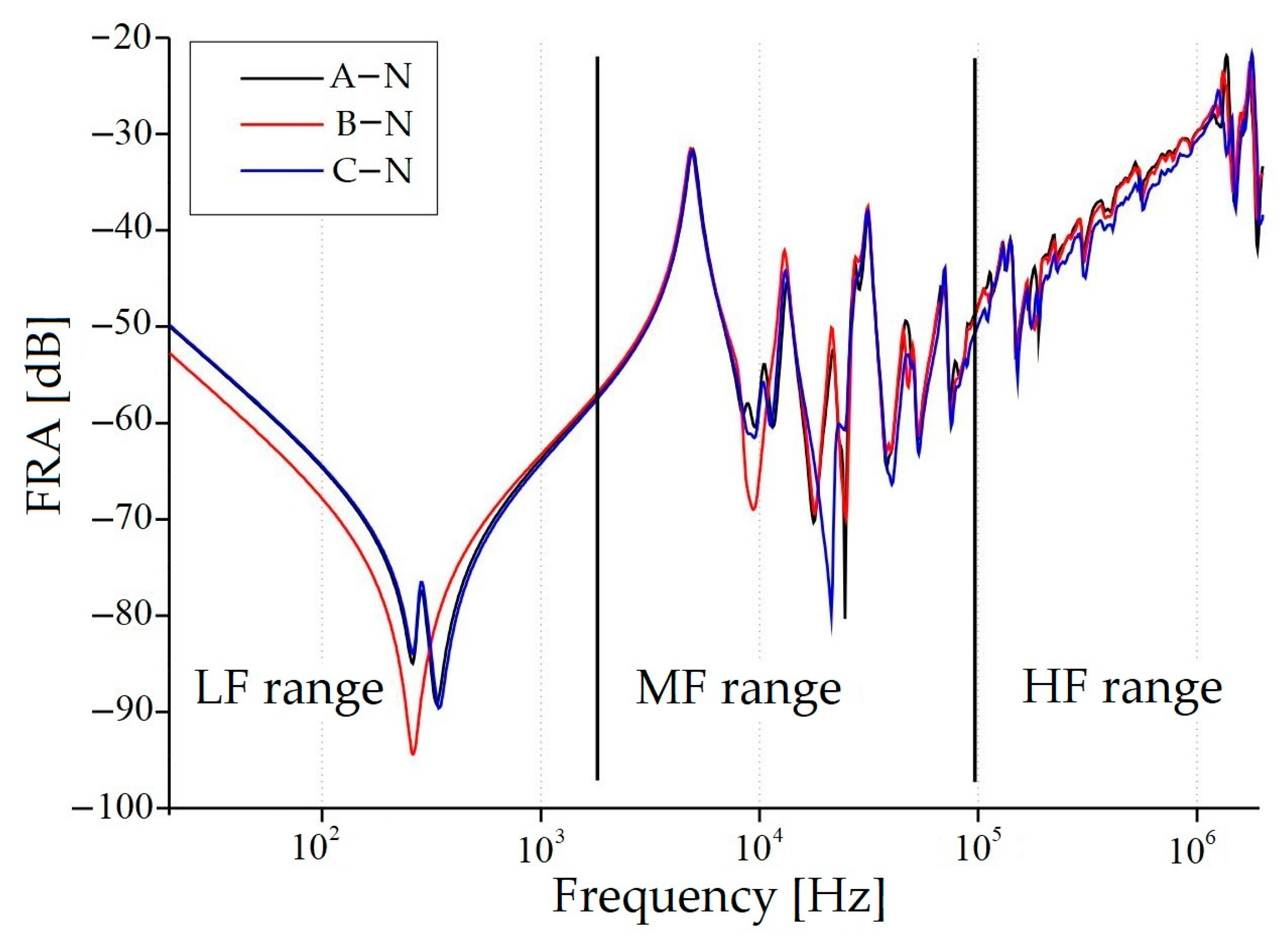
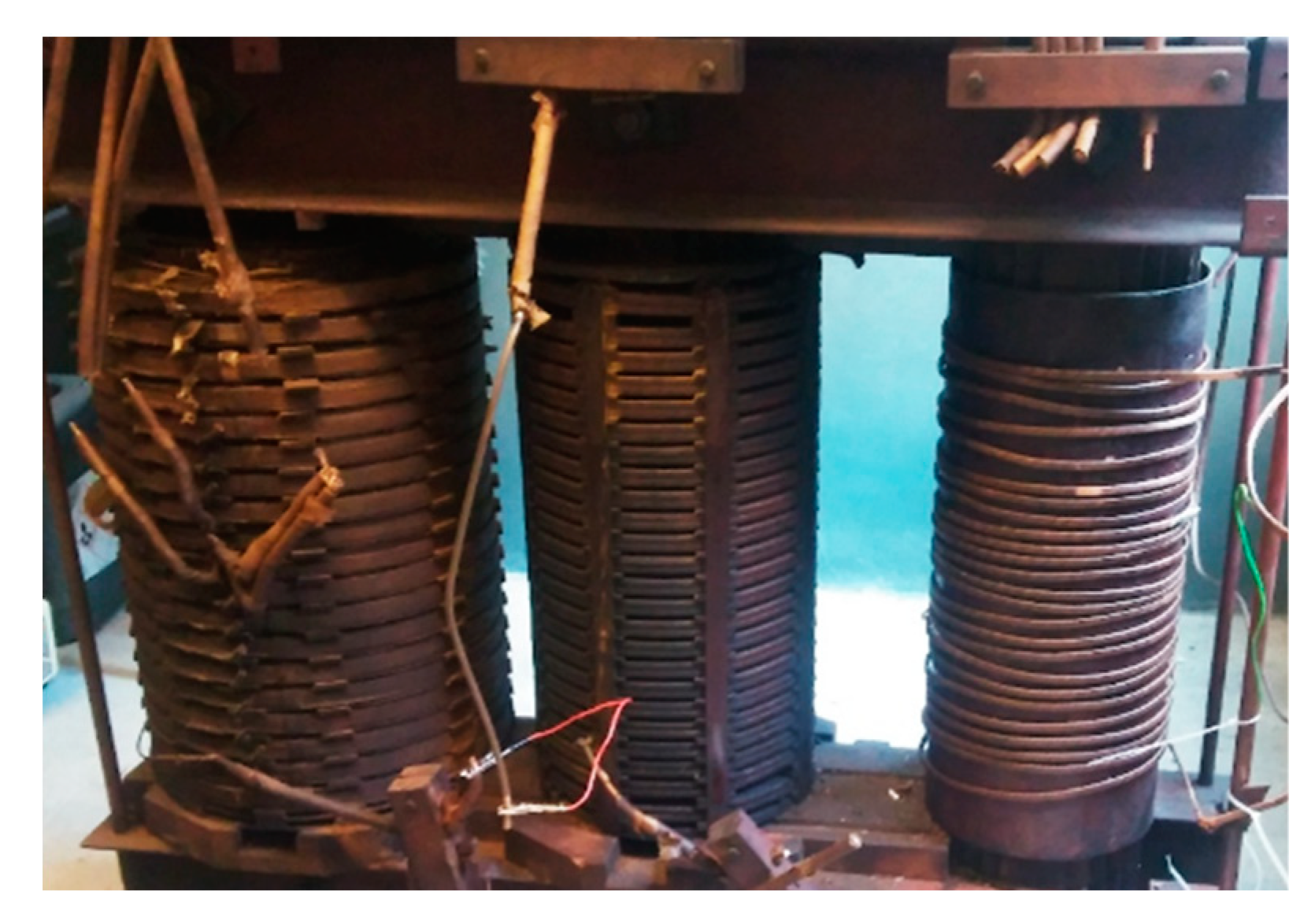
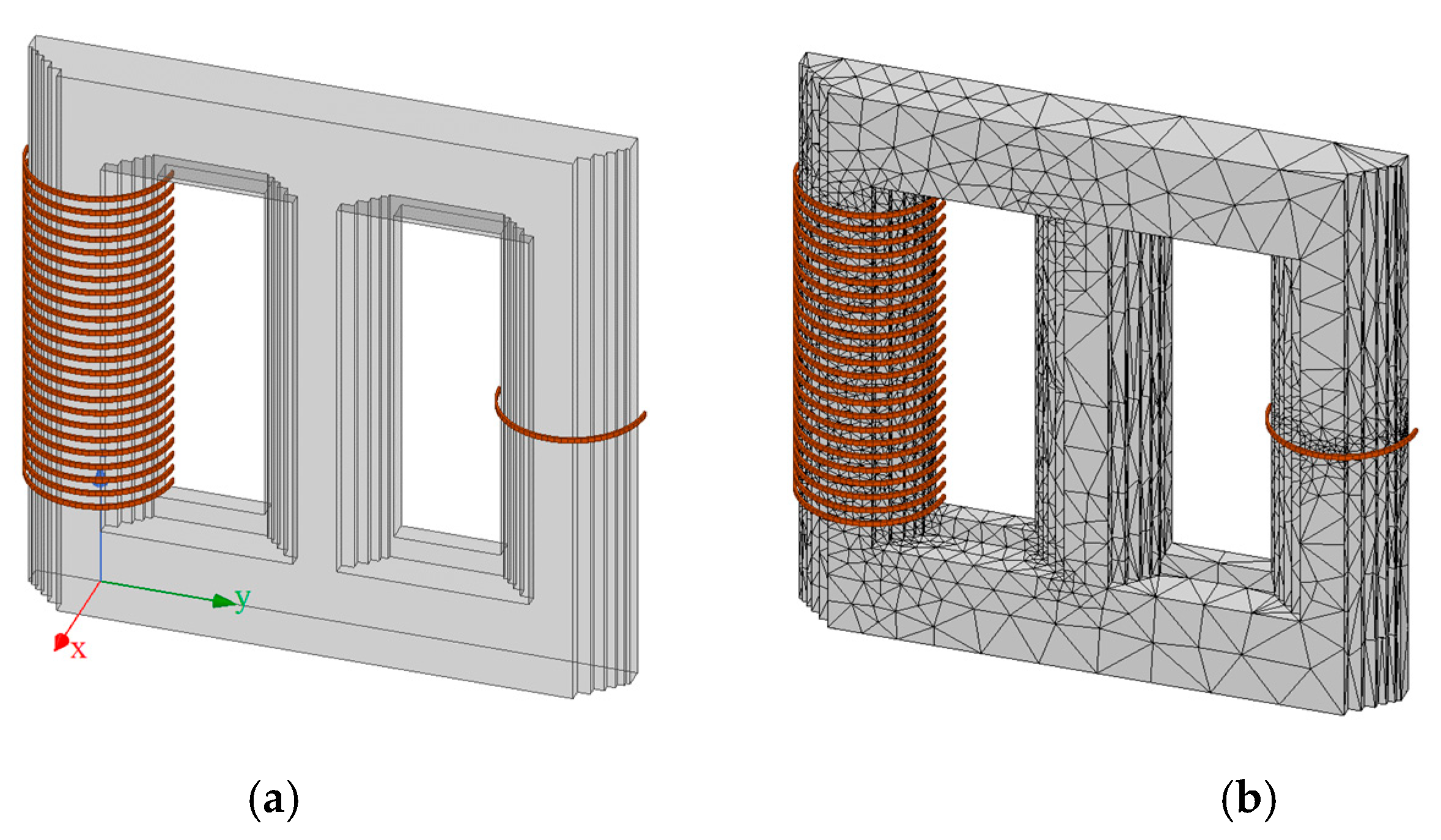
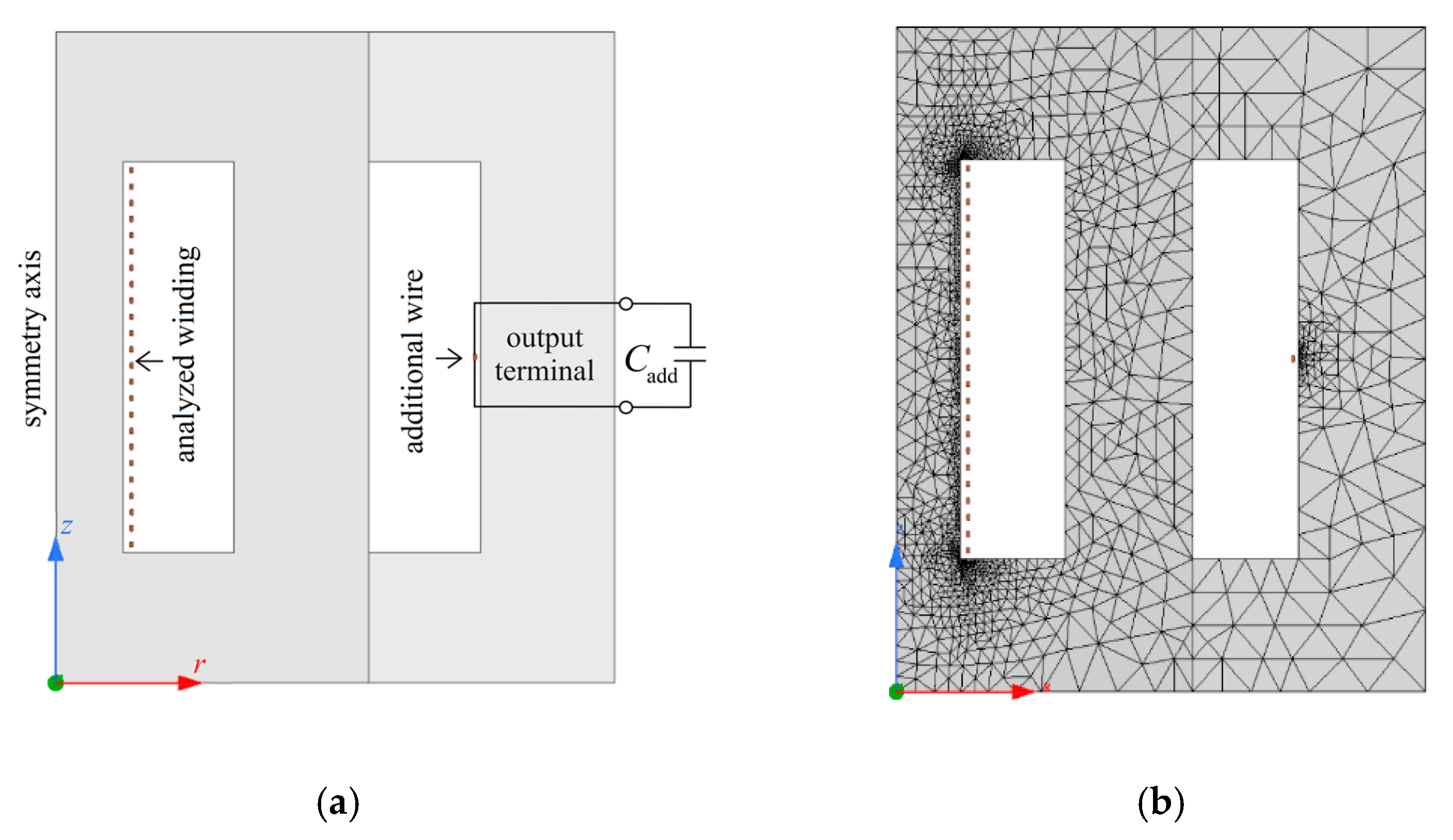
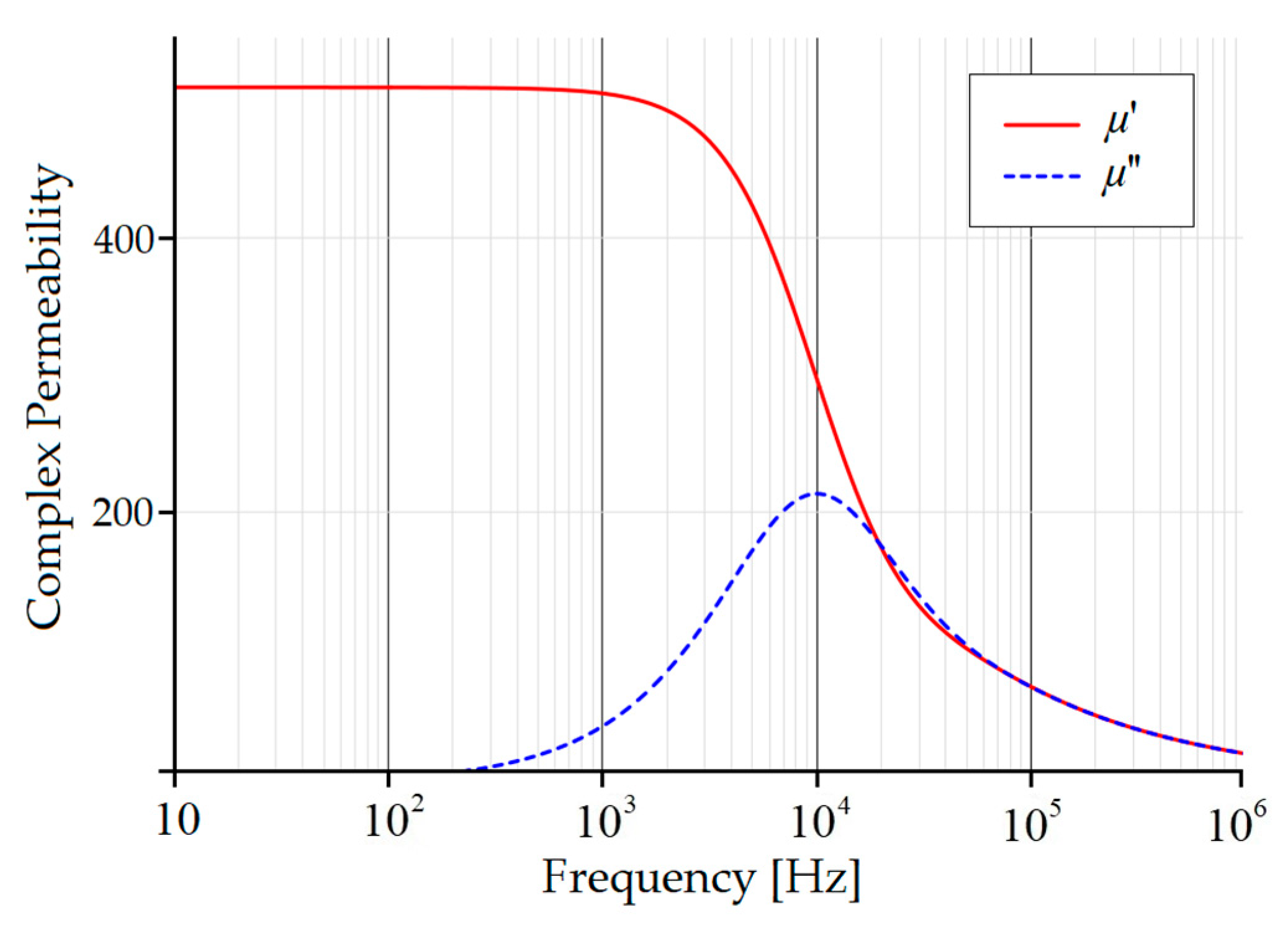

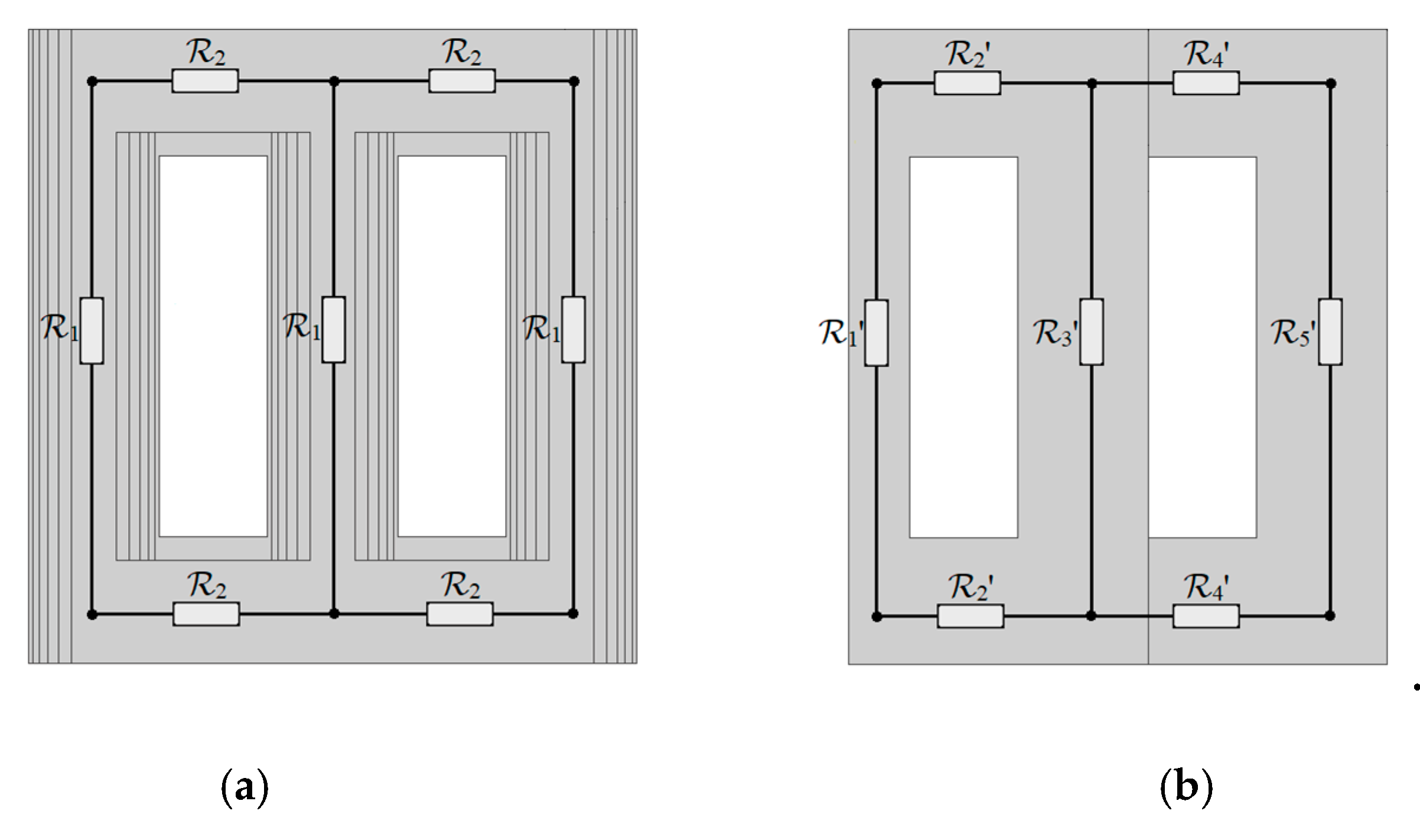

Publisher’s Note: MDPI stays neutral with regard to jurisdictional claims in published maps and institutional affiliations. |
© 2020 by the authors. Licensee MDPI, Basel, Switzerland. This article is an open access article distributed under the terms and conditions of the Creative Commons Attribution (CC BY) license (http://creativecommons.org/licenses/by/4.0/).
Share and Cite
Trela, K.; Gawrylczyk, K.M. FEM Modelling of the Influence of the Remaining Windings on the Frequency Response of the Power Transformer. Appl. Sci. 2020, 10, 7633. https://doi.org/10.3390/app10217633
Trela K, Gawrylczyk KM. FEM Modelling of the Influence of the Remaining Windings on the Frequency Response of the Power Transformer. Applied Sciences. 2020; 10(21):7633. https://doi.org/10.3390/app10217633
Chicago/Turabian StyleTrela, Katarzyna, and Konstanty Marek Gawrylczyk. 2020. "FEM Modelling of the Influence of the Remaining Windings on the Frequency Response of the Power Transformer" Applied Sciences 10, no. 21: 7633. https://doi.org/10.3390/app10217633
APA StyleTrela, K., & Gawrylczyk, K. M. (2020). FEM Modelling of the Influence of the Remaining Windings on the Frequency Response of the Power Transformer. Applied Sciences, 10(21), 7633. https://doi.org/10.3390/app10217633





